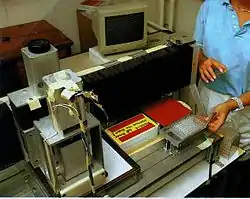German Resource Center for Genome Research
The German Resource Center for Genome Research (RZPD, Resourcenzentrum Primärdatenbank) was a service center for gene and genome research in Berlin-Charlottenburg and Heidelberg.
| Type | service center |
|---|---|
| Headquarters | Berlin-Charlottenburg Heidelberg |
Area served | Germany London |
| Services |
|
History
In 1987 Hans Lehrach and Günther Zehetner founded the Reference Library / Primary Database (RLDB) at the Imperial Cancer Research Fund (ICRF) in London.[1] The RLDB distributed macroarrays generated at the ICRF to research groups worldwide. The macroarrays consisted of clones of genomic and cDNA libraries transferred to 22 × 22 cm nylon filters with the help of robots which have been developed by Zehetner at the ICRF. Experimental results done with the standardized materials were reported back by researches and collected in the Primary Database.[2]
In early 1995 the RLDB was moved to Berlin to the Max Planck Institute for Molecular Genetics, where it continued its work.[3]
In the summer of 1995, the Resource Centre was established as part of the German Human Genome Project (DHGP) by Hans Lehrach (Max Planck Institute for Molecular Genetics (MPIMG), Berlin-Dahlem), Günther Zehetner (MPIMG, until July 2000 Scientific Director of the Berlin Resource Center) and Annemarie Poustka (German Cancer Research Center (DKFZ), Heidelberg). As Resource Center/Primary Database (RZPD) it took over the work of the RLDB. It was funded by the Federal Ministry of Education and Research (BMBF) in order to provide the materials free of charge to the members of the DHGP, while they were available to other researchers at cost prize. The RZPD became the largest database for genetic clones worldwide and was associated with many of the major national and international gene and genome research projects.

The RZPD was one of only two distributors in Europe for IMAGE cDNA clones and also constructed its own plasmid, cosmid, YAC and cDNA libraries. Each clone was stored in a well of a 96 or 384 well microtiter plate, which were kept, while not used for spotting, in deep freezers at -80 °C.
On 1 July 2000 the RZPD was converted into a Non-Profit-Gesellschaft mit beschränkter Haftung (gGmbH). This company with limited liability was supported by three of the most important research companies in Germany: the Max Planck Society, the German Cancer Research Center and the Max Delbrück Center for Molecular Medicine (MDC Berlin-Buch). As scientific company members served Hans Lehrach (MPIMG), Annemarie Poustka (DKFZ), Jens Reich (MDC) Matthias Uhlen (Karolinska Institute, Stockholm) and Harald zur Hausen (DKFZ).
On 31 July 2007 the non-profit company was disbanded. A large part of the existing services was taken over by two new companies. ImaGenes (a start-up company by the former managing directors of the RZPD) and ATLAS Biolabs GmbH, which was co-founded by Lehrach with the former department heads of the RZPD, Uwe Radelof und Bernd Drescher.[4]
Services
.JPG.webp)
The scope of services was constantly expanded and included the provision of genomic cell clones and cDNA databases, cell cultures, microarrays, expression profiles, Affymetrix services and PCR offers. Data collected in the Primary Database were made available to compare experimental results by researches using the globally standardized material provided by the center.[5]
Locations
.jpg.webp)
The RLDB office in London was located in the main ICRF building at Lincoln's Inn Fields, Holborn and later moved to bigger premises in the adjacent Royal College of Surgeons building.
In Berlin the RZPD was first located at the Max Planck Institute for Molecular Genetics in Berlin-Dahlem and then moved to a nearby site at the Harnack road (which today is the site of the Max Planck Institute for the History of Science) before the center relocated to its final location at the former building of the Empress Auguste Viktoria Infant Home in Heubnerweg in Berlin-Charlottenburg. The Neo-baroque building was constructed in the years 1907–1909 under the leadership of architect and Berlin City Commissioner for City Planning Ludwig Hoffmann established, while the planning was significantly influenced by the architect Alfred Messel. The small Heidelberg component of the center was located within the DKFZ.
References
- The Reference Library System - sharing biological material and experimental data. Günther Zehetner and Hans Lehrach (3 February 1994). Nature, vol 367, pp. 489-491
- Preparation and screening of high-density cDNA arrays with Genomic Clones (Methods in Molecular Biology, vol 175:. Genomics Protocols, edited by: MP Starkey and R. Elaswarapu, Humana Press Inc., Totowa, NJ), Günther Zehetner, Maria Pack, and Katja Schäfer (2001), pp. 169-188
- Max-Planck-Institut will Gen-Bank einrichten, Die Welt, 31 May 1995
- RZPD wird ImaGenes – Wirtschaftlicher Erfolg ermöglicht Änderung der Rechtsform GenomXPress 3/07, 2007
- Development and perspectives of scientific services offered by genomic biological resource centers, Oxford Journals, briefings in Functional Genomics and Proteomics 2007, Volume 6, Number 3, pp. 163-170
